The EEGLAB News #6
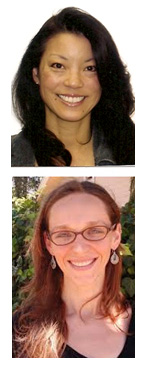 Sandra Loo, Ph.D.
Sandra Loo, Ph.D.
Professor and Director of Pediatric Neuropsychology,
Department of Psychiatry and Biobehavioral Science, David Geffen School of Medicine, Semel Institute for Neuroscience and Human Behavior, University of California Los Angeles
Agatha Lenartowicz, Ph.D.
Assistant Professor of Psychiatry at the David Geffen School of Medicine, Semel Institute for Neuroscience and Human Behavior, University of California Los Angeles
Managing Director, Staglin One Mind Center for Cognitive Neuroscience, Semel Institute for Neuroscience and Human Behavior, University of California Los Angeles
Many researchers hope to drive science forward by designing a study that contributes a new perspective in their field of study. That’s what Dr. Sandra Loo, Professor and Director of Pediatric Neuropsychology at UCLA, did after meeting Dr. Scott Makeig at a 2009 National Institutes of Health (NIH) conference on electroencephalography (EEG).
“We discussed applying Scott’s tools (EEGLAB and ICA) within my research studies, which included children with Attention Deficit Hyperactivity Disorder (ADHD) and their families, as this is something that was not commonly done at that time.” What emerged was a novel and exciting project – to implement cortical source analyses to EEG data collected during a spatial working memory paradigm among children with and without ADHD. It had the potential to contribute a new perspective on working memory in ADHD.
At around the same time, Dr. Loo began mentoring then post-doctoral fellow Dr. Agatha Lenartowicz, who shared the same interest in ADHD, EEG, and working memory. Dr. Loo invited Dr. Lenartowicz to take part in the grant with Dr. Makeig, to help with data analyses.
 This collaboration proved invaluable, producing several publications, including the first cortical source level, event-related spectral assay of working memory in ADHD. (Lenartowicz A, et al., 2014, J Neuroscience). “It created a new perspective on attention deficits in this population,” Dr. Lenartowicz enthuses, “shifting focus from higher order working memory processes to encoding, early visual attention processes. I think this has contributed to a unique, new perspective in the ADHD domain.”
This collaboration proved invaluable, producing several publications, including the first cortical source level, event-related spectral assay of working memory in ADHD. (Lenartowicz A, et al., 2014, J Neuroscience). “It created a new perspective on attention deficits in this population,” Dr. Lenartowicz enthuses, “shifting focus from higher order working memory processes to encoding, early visual attention processes. I think this has contributed to a unique, new perspective in the ADHD domain.”
(Figure. a, The event-related spectral pertubations (ERSPs) for the mid-occipital cluster were characterized by an alpha band (8–12 Hz) event-related decrease (ERD) during encoding (E) and probe (P) periods, and by a somewhat lower-frequency event-related increase (ERI) during memory maintenance (M). Our a priori analyses examined the encoding period (broken-line box), during which alpha ERD was enhanced in typically developing (TD) children and during high-load. The alpha ERD group difference was stronger at low-load than at high-load, consistent with poor WM engagement. Additional analyses revealed a similar pattern of effects for alpha ERI during maintenance. b, The ERSP for the midfrontal cluster showed a (4–7 Hz) theta band ERI during the maintenance interval (broken-line box) that was stronger in children with ADHD and during high-load trials.) (Lenartowicz A, et al., 2014, J Neuroscience)
Attention and Working Memory. Both Dr. Loo and Dr. Lenartowicz have been fascinated by the brain-behavior interaction – specifically attention and working memory – from early in their careers.
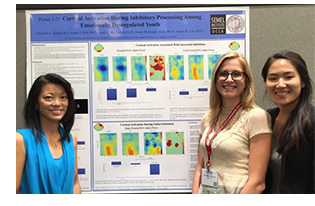 Born and raised in Los Angeles, California, Dr. Sandra Loo received her Ph.D. in Psychology from the University of Hawaii at Manoa (1996). Before coming to UCLA, she was Director of two outpatient clinics specializing in the diagnostic and neuro-cognitive assessment of children with attention and learning disorders at the University of Colorado Health Sciences Center and the University of Massachusetts, where she worked with Dr. Russell Barkley. In her current position as Professor and Director of Pediatric Neuropsychology at UCLA, she continues to work with children who have difficulties with attention, memory, and learning (such as ADHD, learning disorders, autism, dyslexia, Tourette's Syndrome, and obsessive-compulsive disorder). She performs both clinical work and research on brain activity among children with these difficulties. “My lab,” she describes, “has been using EEG measures on brain mechanisms to identify biological markers (biomarkers) of disorder, developmental trajectory, and treatment response.” (Photo to right: Dr. Sandra Loo and research associates at conference presentation of EEG findings)
Born and raised in Los Angeles, California, Dr. Sandra Loo received her Ph.D. in Psychology from the University of Hawaii at Manoa (1996). Before coming to UCLA, she was Director of two outpatient clinics specializing in the diagnostic and neuro-cognitive assessment of children with attention and learning disorders at the University of Colorado Health Sciences Center and the University of Massachusetts, where she worked with Dr. Russell Barkley. In her current position as Professor and Director of Pediatric Neuropsychology at UCLA, she continues to work with children who have difficulties with attention, memory, and learning (such as ADHD, learning disorders, autism, dyslexia, Tourette's Syndrome, and obsessive-compulsive disorder). She performs both clinical work and research on brain activity among children with these difficulties. “My lab,” she describes, “has been using EEG measures on brain mechanisms to identify biological markers (biomarkers) of disorder, developmental trajectory, and treatment response.” (Photo to right: Dr. Sandra Loo and research associates at conference presentation of EEG findings)
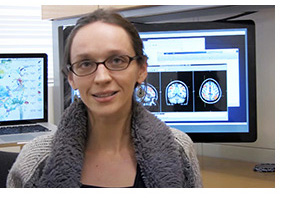 Dr. Agatha Lenartowicz was born in Białystok, Poland, and emigrated with her family when she was 8 years old, to Austria and then Canada (outside of Toronto). She earned her Ph.D. in Psychology & Neuroscience from Princeton University (2008), and gained her first lab experience at the Rotman Research Institute, working with Dr. Randy McIntosh. Since then, she adds, “I never looked back.”
Dr. Agatha Lenartowicz was born in Białystok, Poland, and emigrated with her family when she was 8 years old, to Austria and then Canada (outside of Toronto). She earned her Ph.D. in Psychology & Neuroscience from Princeton University (2008), and gained her first lab experience at the Rotman Research Institute, working with Dr. Randy McIntosh. Since then, she adds, “I never looked back.”
Dr. Lenartowicz’s focus has been on understanding how attention works, and using this understanding to help improve attention, and therefore learning and well-being. “I have always been fascinated with people ... how we behave, how we interact, how we make our choices.” She is specifically interested in understanding the neural systems that allow us to attend and control distractions. She offers an example: "When you're reading on a bus and you hear fellow passengers talking, in an ideal situation you can ignore the voices. But sometimes you can't. Maybe you're tired. So that's fatigue. Maybe you're really excited by dinner that evening, so that's an internal distraction. There are many reasons why distractions can happen. Understanding how those different distractions come about through brain mechanisms, I think, will be really fundamental to better understanding causes of distractibility or conditions such as ADHD.” One question in particular has captured her attention: “Are working memory and attention the same neural system?” This was the first research question Dr. Lenartowicz asked and continues to ask. “If I could answer that question, I think many other answers would follow. Being able to answer this question would signify considerable progress in brain technology and neuroscience.” (Photo credit: LabTV)
Collaboration. With their overlap in interests, it was only time until these two researchers joined forces.
A colleague introduced Dr. Loo to then post-doctoral fellow Dr. Lenartowicz, and their productive mentorship began. Dr. Loo explains, “Dr. Lenartowicz was a post-doc with Dr. Russ Poldrack at the time, and Russ and I were co-investigators on the CIDAR-TRECC grant, which was the research project whose data was the basis of my first grant with Scott Makeig.” Dr. Loo took Dr. Lenartowicz on as her mentee and welcomed her on the team with Dr. Makeig.
 Since then, the three researchers have worked on several exciting projects together. All have involved children with neurodevelopmental disorders, EEG data re-analysis, new data collection with MoBI, and development of group SIFT. “We use neuroimaging technologies like EEG, fMRI and EEG-fMRI,” Dr. Lenartowicz explains, “to study brain dynamics and brain networks that make attention and attention control, work or fail. Through fortunate collaboration with Dr. Loo, I have developed a research arm whereby together we examine how such network contribute to ADHD.” She continues, “My love of data and complex analyses made the collaboration a good fit. I essentially helped to apply the spectral analyses to EEG data collected in a large sample of children (collected in Dr. Loo’s lab) with ADHD. Because I loved the analysis aspect, I jumped in to really explore how these new techniques could give us a new perspective on working memory in ADHD, which we measured using EEG collected during a working memory task.” (Photo: Dr. Lenartowicz prepares a participant for an fMRI scan.; Credit: LabTV)
Since then, the three researchers have worked on several exciting projects together. All have involved children with neurodevelopmental disorders, EEG data re-analysis, new data collection with MoBI, and development of group SIFT. “We use neuroimaging technologies like EEG, fMRI and EEG-fMRI,” Dr. Lenartowicz explains, “to study brain dynamics and brain networks that make attention and attention control, work or fail. Through fortunate collaboration with Dr. Loo, I have developed a research arm whereby together we examine how such network contribute to ADHD.” She continues, “My love of data and complex analyses made the collaboration a good fit. I essentially helped to apply the spectral analyses to EEG data collected in a large sample of children (collected in Dr. Loo’s lab) with ADHD. Because I loved the analysis aspect, I jumped in to really explore how these new techniques could give us a new perspective on working memory in ADHD, which we measured using EEG collected during a working memory task.” (Photo: Dr. Lenartowicz prepares a participant for an fMRI scan.; Credit: LabTV)
As Dr. Lenartowicz anticipated, their studies have created an exciting new perspective on attention deficits in children.
 EEGLAB. EEGLAB has been an invaluable tool in Dr. Loo and Dr. Lenartowicz’s research. Dr. Loo explains, “EEGLAB has helped us to identify cortical source generators of signal so that we can better understand neural mechanisms underlying cognitive deficits in neurodevelopmental disorders.”
EEGLAB. EEGLAB has been an invaluable tool in Dr. Loo and Dr. Lenartowicz’s research. Dr. Loo explains, “EEGLAB has helped us to identify cortical source generators of signal so that we can better understand neural mechanisms underlying cognitive deficits in neurodevelopmental disorders.”
Dr. Lenartowicz concurs. “EEGLAB is a core tool, a workhorse of our EEG analysis. EEG data is part of every project in my portfolio and EEGLAB is a key tool in each analysis pipeline. We write a lot of custom scripts in Matlab,” she clarifies, “and also use FSL and shell scripts for fMRI analysis. All of these tools are intermixed in our data analysis. In some cases, we use EEGLAB for spectral analysis or ICA decomposition and then switch to custom scripts to do another step.” She pauses, reflecting, “In the end, we helped to bring Dr. Makeig’s tools to life in our ADHD research. These tools are still very much focal to our work, and I continue to watch carefully the developments at the Swartz Center for Computational Neuroscience (SCCN).”
While routinely using EEGLAB, Dr. Loo and Dr. Lenartowicz have also contributed to it in invaluable ways: “During my funded projects” Dr. Loo explains, “we helped troubleshoot various EEGLAB processes (generally Dr. Lenartowicz with Dr. Arnaud Delorme) and the development of groupSIFT (via Dr. Makoto Miyakoshi on our Tourette’s projects).”
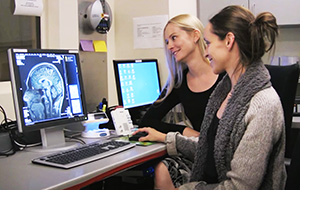 Dr. Lenartowicz has a more humorous take on her contribution: “I would say I am involved in contributing debugging expertise to EEGLAB! I have worked on it for many years and am always one of the folks who breaks tools, and then seeks out causes of bugs and communicates them to developers. So, I hope this has, over the years, contributed to a better product! I am a good early beta tester. We also do lab work on new routines. Some of these are almost ready for EEGLAB plugin-integration.” (Photo: Dr. Lenartowicz setting up scanning parameters in preparation for the MR scan Credit: LabTV)
Dr. Lenartowicz has a more humorous take on her contribution: “I would say I am involved in contributing debugging expertise to EEGLAB! I have worked on it for many years and am always one of the folks who breaks tools, and then seeks out causes of bugs and communicates them to developers. So, I hope this has, over the years, contributed to a better product! I am a good early beta tester. We also do lab work on new routines. Some of these are almost ready for EEGLAB plugin-integration.” (Photo: Dr. Lenartowicz setting up scanning parameters in preparation for the MR scan Credit: LabTV)
The Future. The mentorship-turned-collaboration between Drs. Loo and Lenartowicz continues to thrive. In 2015, Dr. Lenartowicz took an Assistant Professor position and began her own lab. She also became Managing Director of Staglin One Mind Center for Cognitive Neuroscience at UCLA. While they continue to work very closely together – being co-Principal Investigators on grants – they also maintain their own projects and goals for the future.
Dr. Loo maintains envisions specific, unwavering goals. “In the next few years,” she resolves, “I hope to accomplish the following: 1) map the neural network associated with posterior alpha band decrease during visual attention; 2) validate the neural mechanisms underlying a new neuromodulation treatment (i.e., external trigeminal nerve stimulation (TNS)) for ADHD; and 3) identify EEG correlates of successful and unsuccessful suppression of urges (e.g., eye blinks or tics) in children.”
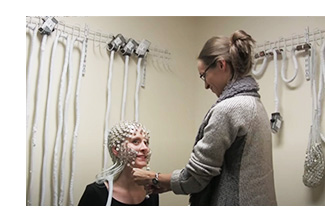 Dr. Lenartowicz maintains her own vision for the future. Along with her drive to understand how attention works and her love of technology and data, she feels a profound need to make her work translational. “I would like to: 1) streamline the integration of EEG and fMRI data, 2) to develop a program employing ultrasound technology for testing causal hypotheses, and finally, 3) to really develop a practical, translational program that could help people with attention problems,” she relates emphatically. “My chief goal is to create solutions that you can apply today to improve your attention and therefore well-being.” She describes a collaboration with Dr. Jennie Grammer in the Graduate School of Education at UCLA, of which Dr. Loo is also a part: “This novel, exciting project examines attention in kids with and without ADHD in the classroom, to better understand the contexts in which attention and therefore learning blossoms.” She pauses, adding, “I always think about the parents of the kids who come in with ADHD. What can I tell them? I would like to give them a concrete answer about what is wrong, what they can do.” (Photo: Dr. Lenartowicz applying an EEG cap, used to acquire EEG signals on the scalp. The cap is compatible with MRI allowing for concurrent acquisition of electrical and metabolic signals from the brain; Credit: LabTV)
Dr. Lenartowicz maintains her own vision for the future. Along with her drive to understand how attention works and her love of technology and data, she feels a profound need to make her work translational. “I would like to: 1) streamline the integration of EEG and fMRI data, 2) to develop a program employing ultrasound technology for testing causal hypotheses, and finally, 3) to really develop a practical, translational program that could help people with attention problems,” she relates emphatically. “My chief goal is to create solutions that you can apply today to improve your attention and therefore well-being.” She describes a collaboration with Dr. Jennie Grammer in the Graduate School of Education at UCLA, of which Dr. Loo is also a part: “This novel, exciting project examines attention in kids with and without ADHD in the classroom, to better understand the contexts in which attention and therefore learning blossoms.” She pauses, adding, “I always think about the parents of the kids who come in with ADHD. What can I tell them? I would like to give them a concrete answer about what is wrong, what they can do.” (Photo: Dr. Lenartowicz applying an EEG cap, used to acquire EEG signals on the scalp. The cap is compatible with MRI allowing for concurrent acquisition of electrical and metabolic signals from the brain; Credit: LabTV)
On their future paths, one thing is certain: EEGLAB remains a key tool. Dr. Lenartowicz elucidates, “When we adopt tools in research, there is always a choice, open source and messy, or commercial and inflexible. My experience with the SCCN team, Dr. Makeig and his crew, has been exceedingly productive and positive. I embrace the open-science, open-source community, with all its bugs and its errors. It represents to me honesty and truth, which ultimately lead to progress.”
R. Weistrop, September 2020
_______________________
Videos
- Meet Sandra K. Loo, Ph.D. on kidsinthehouse:
https://www.kidsinthehouse.com/all-parents/experts/introductions/meet-sandra-k-loo-phd
- Additional video links of Dr. Loo discussing Dyslexia and ADHD are included at the bottom of this page: https://www.youtube.com/watch?v=-GYRLyt69zY
- Interview with Agatha Lenartowicz, Ph.D. - “Agatha is Exploring the Mind at UCLA” on LabTV: https://www.youtube.com/watch?v=ORfIItbh5-Q
Publications
Lenartowicz, A., Truong, H., Salgari, GC, Bilder, RM, McGough, J., McCracken, JT, Loo, SK. (2019). Alpha modulation during working memory encoding predicts neurocognitive impairment in ADHD. Journal of Child Psychology and Psychiatry. 60(8):917-926. 18 March 2019 https://doi.org/10.1111/jcpp.13042
Lenartowicz, A., Mazaheri, A., Jensen, O., Loo, SK (2018). Aberrant modulation of brain oscillatory activity and attentional impairment in ADHD. Biological Psychiatry Cognitive Neuroscience and Neuroimaging, 3(1), 19-29. NIHMS 911176
Loo SK, Lenartowicz A, Makeig S. (2016). Research Review: Use of EEG biomarkers in child psychiatry research - current state and future directions. J Child Psychol Psychiatry. 2016 Jan;57(1):4-17. doi: 10.1111/jcpp.12435. Epub 2015 Jun 23.PMID: 26099166
Lenartowicz A, Delorme A, Walshaw PD, Cho AL, Bilder RM, McGough JJ, McCracken JT, Makeig S, Loo SK (2014). Electroencephalography correlates of spatial working memory deficits in attention-deficit/hyperactivity disorder: vigilance, encoding, and maintenance. J Neurosci, Jan 22;34(4):1171-82. doi: 10.1523/JNEUROSCI.1765-13.2014. PMID: 24453310